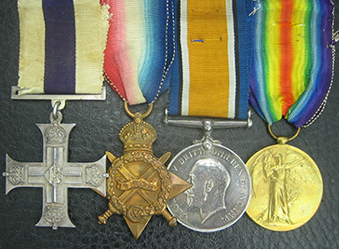
MILITARY CROSS, G.V.R., UNNAMED AS ISSUED; 1914-15 STAR ‘17607 L. CPL. G. H. POTTS. LAN: FUS:’, BRITISH WAR AND VICTORY MEDALS ‘2. LIEUT. G. H. POTTS.’
M.C. London Gazette 10 December 1919: T/2nd Lt. George Henry Potts, Lanc. Fus., attd. 16th Bn.
‘During the attack on the Oise-Sambre Canal on 4th November, 1918, he was one of the first to attempt to make the crossing, under heavy fire, of the bridge constructed by the R.E.’s When the advance was continued on the enemy’s side of the canal, he led his company with great skill and courage, capturing all his objectives.’
George Henry Potts attested for the Lancashire Fusiliers on 1 March 1915 and served with the 19th Battalion during the Great War on the Western Front from 23 November 1915. Appointed Lance-Corporal and afterwards promoted to Acting Sergeant, he returned to England and was commissioned Second Lieutenant in the 3rd Battalion, Lancashire Fusiliers on 25 June 1918. He saw further service during the Great War on the Western Front attached to the 16th (2nd Salford Pals) Battalion from 18 August 1918, and was awarded the Military Cross for his gallantry during the crossing of the Oise-Sambre Canal, during the Second Battle of Sambre, on 4 November 1918.
During the attack, 2nd Salford Pals, along with the 2nd Manchester’s, who formed part of 32nd Division, were tasked with crossing a particularly heavily defended part of the canal. Both battalions suffered heavy casualties and although elements of both were eventually able to cross and took some of their objectives, their bridges were constantly being destroyed and it was finally decided to recall them and attempt a crossing elsewhere:
“At 3.30am on 4th November the 16th Bn moved to its forming up line in an orchard close to the canal and lay down with all ranks facing the latter. A heavy barrage of artillery and machine guns opened at 5.45am. Five minutes later the companies of the 16th dashed up to the bank of the canal, 2nd Lt. P.G. Horsler greatly distinguished himself, and opened fire to cover the Royal Engineers while they put up the bridges. The Sappers completed their task in half an hour in the face of great difficulties. As soon as the bridge to be used by the 16th was ready, 2nd Lt. C.J. Stapley was one of the first to cross it, though under intense machine-gun fire. But as Captain H.C. Pemberton began to cross it, the floats at the enemy's end of the bridge broke loose. By now heavy machine-gun fire was being directed at the enemy at the bridges. In spite of it, Pemberton and Stapley succeeded in repairing it; and 2nd Lt. G.H. Potts and three men were able to get across it before it was again broken by shell fire. The battalion was thus held up. Lt. Col. Marshall at once came forward and organised parties to repair the bridge. The first party formed were soon all killed or wounded. But such was the inspiration of Marshall's example that volunteers sprang forward to take their place. He stood on the bank under intense fire and with complete disregard of his own safety, encouraging them and helping in the work. In spite of the German fire, the repairs to the bridge were completed. Marshall tried to rush across at the head of the company waiting to cross. He was shot through the head and instantly killed.”
https://www.lancs-fusiliers.co.uk/LFVCcs/Neville%20Marshall%20VC.htm
War diary 4 Nov 1918 notes 2nd Lieutenant Potts of ‘D’ Company among the wounded’. The Battalion lost 11 Officers killed wounded or missing, including 3 from ‘D’ Company. Other ranks casualties are not listed but the regimental history states that the Battalion could only muster 100 rifles by the end of the day. Notably amongst the casualties in the 2nd Manchester’s was the death of the poet Wilfred Owen.
http://www.wilfredowen.org.uk/wilfred-owen/wilfreds-places/ors
Potts ended the War in the rank of Acting Captain. For their gallantry during crossing of the Oise-Sambre Canal, the 16th Battalion were awarded 1 VC, 2 DSO’s, 1 bar to the MC, 5 MC’s, 1 bar to the MM and 8 MM’s.
A newspaper cutting about the award of the then Acting Captain Pott’s award of the Military Cross (which includes a photo of Potts), tells how though at this point no details of the exact reason for the award, it was thought to be for an engagement at one of the canals on 4 November 1918. It tells how Potts;
“assisted in the erection of a bridge under shell fire and was blown with the bridge into the canal and whilst swimming for safety was fired upon."
This above clearly happened during an earlier attempt to cross, as multiple sources state Potts and 3 men were able to cross just after Captain Pemberton and a small number of men.
https://salfordwarmemorials.proboards.com/thread/1204/awards?page=13
Potts is quoted several times in relation to the attack and the death of Colonel Marshall in ‘A Hero For All Times: Marshall VC in The Great War’.
Condition VF, Sold with copied research, including War diary extracts (digital). An extremely fine award for this extremely hard found battle.